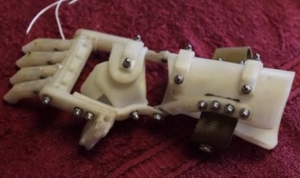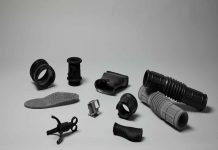A South African carpenter who lost four fingers on his right hand to an accident two years ago has teamed up with a Seattle-based designer to invent Robohand, an arm prosthesis that looks like a robot’s hand made from cables, screw, 3D printing and thermoplastic.

Fox News featured the story which has now evolved into a global mission to spread the device as widely as possible and provide hands for people around the world.
Richard Van As lost his right hand fingers to a circular saw and has been unable to afford a myoelectric hand which costs tens of thousands of dollars. Refusing to take the painkillers, Richard says the more pain he felt, the more ideas came to his mind. That’s when he decided to build his own hand.
“Sometimes you have to chop fingers off to start thinking,” Richard told The Associated Press.
Richard contacted Ivan Owen in Seattle after seeing an online video about a mechanical hand that was used as a costume in a theatre production.
“Ivan was a gift to me,” Richard said.
The duo then invented a device that uses the rotation of a joint to enable five plastic digits to grasp.
According to the Robohand website, they have discovered that there are no functioning replaceable digits that don’t cost the earth.
“If you cut off your whole hand there are prosthesis widely available to you, but if you lost your fingers there are no replaceable digits.”
The device that was developed by Richard and Ivan costs about $500 to make and can be replicated using plans on the Internet and a 3D printer. At first the team used a milling machine to make a metallic robotic forefinger for Richard, but they eventually shifted to 3D printing to create the device using plastic.
According to the Fox News feature, using a 3D printer allows for greater flexibility so that the device can be resized on the computer for each user and manufactured through the printer.
“A glove-like covering is fitted in thermoplastic, and then fingers are created on the 3-D printer by melting and stacking plastic to make Lego-like digits which are connected to the glove with small cables and screws.”
Brooklyn-based 3D printer producer MakerBot has decided to help Robohand with its cause by donating two printers, one for Johannesberg and the other for Seattle.
“What was taking us two weeks to put together took us 20 hours,” Richard said. “Now it looks easy.”
“We took the 3-D printing world by surprise. It wasn’t the first medical breakthrough in the 3-D world, but people are eager to get a hold of it now.”
To make the Robohand available on a wider scale the team launched the Open Source design online and now collects donations to produce hands for people around the world.
They are also working on a design to help kids with Amniotic Band Syndrome, a condition in which a child is born without appendages because circulation was cut off in the womb by amniotic bands.




















